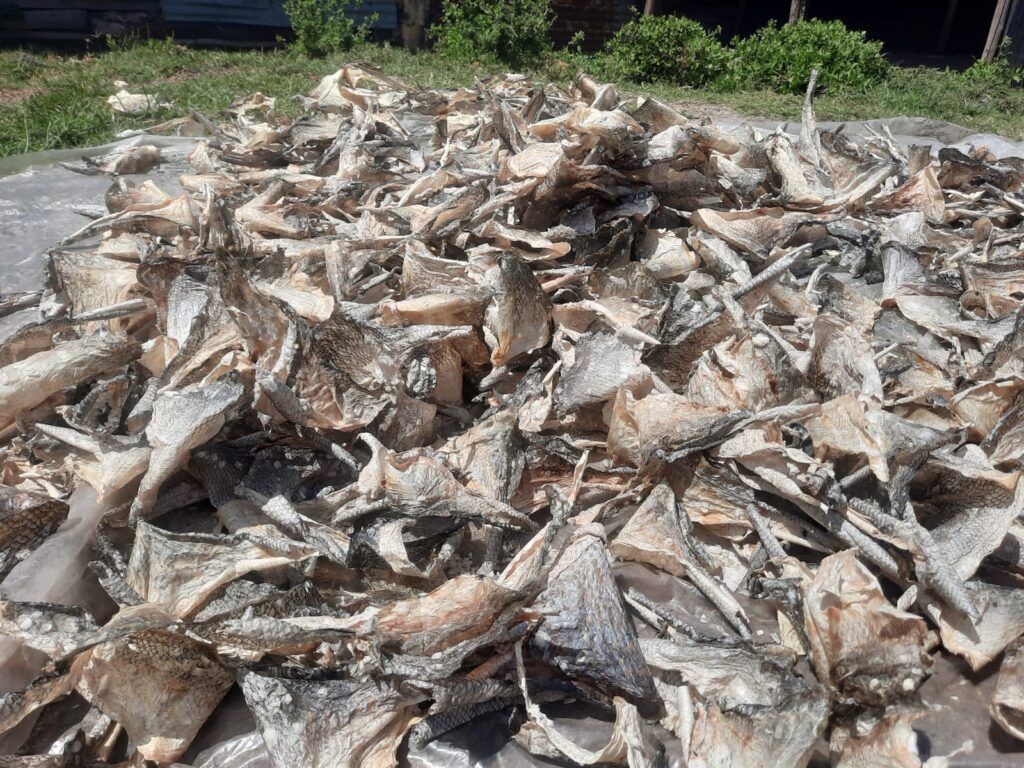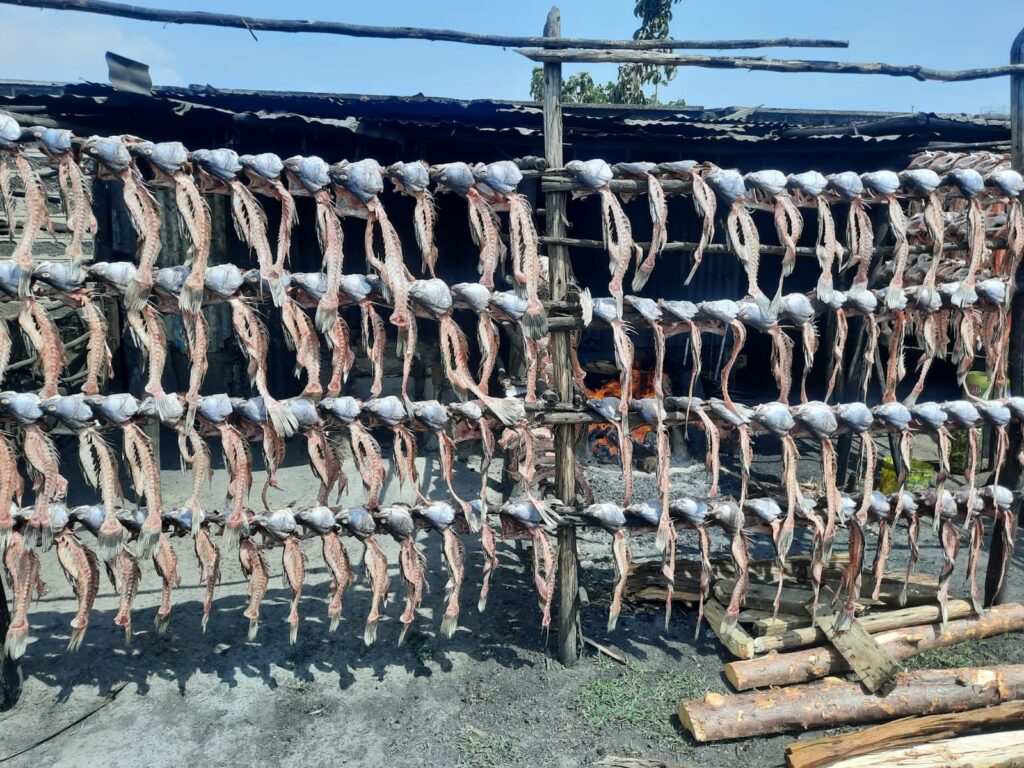Twenty years ago, strong foul stench emanating from heaps of waste was the order of the day near fish processing factories in Kisumu.
Huge sized house flies hoovered around to scavenge for the delicacy with some wild birds.
From the heaps, a group of women in Obunga discovered a lifeline, and today, the heaps are no more.
Caren Anyango, who hails from Homa Bay County, has lived in Kisumu for over 20 years.
But 14 years ago, she ventured into the business of recycling fish skin wastes.
“We started the business with a group of 12 women,” said Anyango.
Annually, Kisumu produces about 150, 000 metric tonnes of fish waste yearly.
This is mainly from Nile Perch whose fillet is exported to European countries.
When processing the fillets, the fish skin is peeled off.
The sewer coverage in Kisumu town is as low as below 20 percent. This means a lot of liquid waste which is not managed finds its way into the lake
Tom Togo
LAKE VICTORIA POLLUTION
Previously, such skin would be dumped in adjacent dumping sites, attracting scavenging birds, and houseflies.
The decomposed skin would then produce a strong stench, polluting the air for those living and working around the fish processing factories.
When it rains, the components of the waste would be swept back into Lake Victoria, causing pollution of the lake.
According to the National Environmental Management Authority (NEMA) pollution from human activities is one of the biggest challenges facing the Lake Victoria ecosystem.
Tom Togo, NEMA’s Kisumu County Director of Environment, says Lake Victoria is facing pollution emanating from as far as 50 kilometres away.
According to Mr Togo, pollution from industrial and agricultural activities lead to pollution of the lake at 40 percent, followed by pollution from domestic waste at 30 percent.
“The sewer coverage in Kisumu town is as low as below 20 percent. This means a lot of liquid waste which is not managed finds its way into the lake,” he said.
Recent death of fish reported in the lake was attributed to pollution and impacts of climate change.
The waste was polluting our environment, after attending training at KIRDI we approached a fish processing plant which started supplying us with fish skin and bones
Caren Anyango
HOW IT ALL STARTED
The women got the idea from Kenya Industrial Research Development (KIRDI).
“The waste was polluting our environment, after attending training at KIRDI we approached a fish processing plant which started supplying us with fish skin and bones,” said Anyango.
While selling fish, the women started saving and were able to pool resources which went into the new venture.
The raw materials are easily available given that Nile perch accounts for 70 per cent of the total fish catch from Lake Victoria.
The women collect waste from the plant after filleting.
100 Kilograms of Nile perch skin from the plant is sold at Sh.1,220.

Once sorted the Nile Perch skin is taken to the Kenya Industrial Research Development (KIRDI) for tanning.
We use the leather products to make shoes, sandals, belts and jackets
Caren Anyango
TANNING
Tanning involves treating the skin to produce durable leather that is less susceptible to decomposition.
This takes a week given that fish has high oil content.
The scale is used to produce collagen, which is one of the useful materials from fish used as shoe cement or glue.
The collagen is then subjected to tanning to obtain fish leather.
The skins are churned, soaked, fleshed, and dried in the open air.
The tanning process prevents the leather from becoming stiff once all the oils are removed.
The leather is then used to make foot wear, handbags and other products.
“We use the leather products to make shoes, sandals, belts and jackets,” said Anyango.
Fish has since emerged as a new alternative source of leather in what could potentially change Kenya’s leather manufacturing and fashion industry.
Before the bones from the process decompose, they are cleaned and we use the fin bone and neckbone to make necklaces and bracelets.
We develop products based on orders in the market so that we have a ready market
Caren Anyango
MARKET
At the start of the business, the women targeted the global market.
Lack of marketing channels however remains one of their biggest challenges to the women.
“We started by exports, but after the Covid pandemic the sales went down, we now only have the local market,” said Anyango.
The women come up with an innovation based on the market demand.
“We develop products based on orders in the market so that we have a ready market,” she furthers.
A pair of shoes made from fish skin leather goes for Sh1,000 in the local market and Sh1,500 if sold outside while a handbag made from the same costs Sh.6,000 locally.
Kenya Marine and Fisheries Research Institute (KMFRI) official Dr. Christopher Aura said that the stock of Nile perch is dwindling due to use of illegal gears adding that overfishing could kill the sub sector.
“Stocks of Nile perch have really declined and getting very big fish to enable fish mongers get large skins has been a great challenge,” he said.
MGONGO WAZI
Besides making leather products, the skeleton remains of fish popularly known as ‘Mgongo Wazi’ (bare back) which would have otherwise been disposed as waste end up in tables as delicacies after a detailed process of preparation.

“We clean them first before cutting them to pieces. Then we dry them and after they are dry, we light fires and deep fry them,” said Petronila Achieng, a fish monger at Obunga.
Achieng is among hundreds of fish mongers at Obunga who earn a living from the ‘mgongo wazi’ trade.
“We buy ‘mgongo wazi’ because it is cheap an life now has become unbearable”
Jacob Ouma
She learnt the art from her mother when she was 13 years old and this is now a family business.
The heads and bones are cleaned, dried in the sun for close to two hours before being boiled in hot oil.
Once it is prepared a majority of it is sent to neighbouring towns like Kakamega, Bungoma, Busia and Vihiga while the rest is sold locally.
Despite containing just shreds of flesh or sometimes no flesh at all, ‘Mgongo Wazi’ is a popular delicacy for low-income earners across western Kenya.
“We sell it at Sh.60 but a whole fish is weighed and sold per kilogram. A kilo goes for Sh.320,” she said.
“We buy ‘mgongo wazi’ because it is cheap an life now has become unbearable,” said Jacob Ouma a resident of Kisumu town.
With the purchase of the ‘mgongo wazi’, fish mongers like Achieng are able to provide for their families and ensure their children can go to school.
She admits that the business has been slow recently due to the hard economic times but remains optimistic that the business will be on track soon.
The final remains which are the fish scales are recycled into chicken and pig food and later sold in agrovets.
